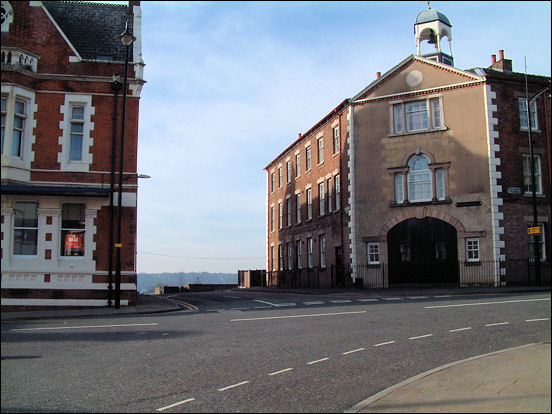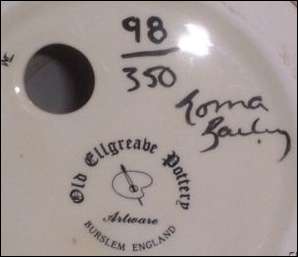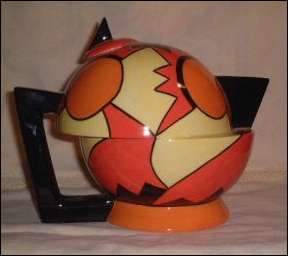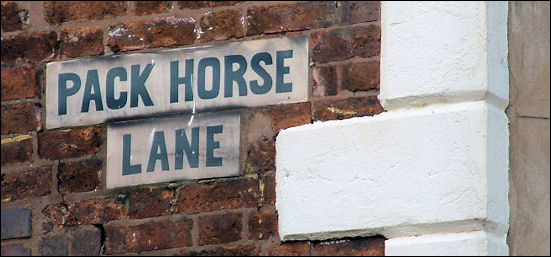|
Burslem
- 'Packhorse Lane - the lifeline of the Potteries'
  
click the
"contents" button to get back to the main index & map
next: Dimsdale and the old Roman Road
previous: the Victorian suburb on the way to Burslem
|
Historian Fred Hughes
writes....
After 250
years the views our forefathers looked out upon are returning to the
Potteries. As the last ugly workplaces are being demolished we can see
again a landscape that was here before industry. And what sensational
vistas they must have been.
“The
projection of land that Burslem stood upon had superb westerly views
across the Fowlea Valley into the foothills of Bradwell Woods,” says
historian Steve Birks. “For most of the last 250 years steel mills, iron
and coalmines, pottery ovens and slagheaps have stood in the way. Now
they’re going we can once again see the true landscape that the pioneering
potters destroyed.”
One such view is from the head of Packhorse Lane in Burslem.

Pack Horse lane still
exists between the bank on the left and the restored works of Enoch Wood
(now converted into flats).
|
“In 1710
there were around 500 people employed in pottery in the entire region. In
Burslem alone, by 1760 the numbers had climbed to 150 manufactories
employing 7,000 people,” says Steve. “And a further 25 years on there were
15,000 workers across the whole of the Potteries.”
During
these early times pottery was carried to market on the shoulders of the
potters, or on the backs of mules.
“The
packhorse route followed a lane from Burslem to Newcastle via Bradwell,”
Steve continues.
“From Newcastle the freight was carried to Winsford in Cheshire, a town
that developed because of its salt trade valued here for glaze. By 1721
Winsford’s River Weaver was transformed into a principal watercourse
allowing freight to be transported to the docks at Liverpool. But the 30
mile journey from Winsford to the Potteries still had to be negotiated by
packhorse often to a cost of disastrous breakage.”
Some of
these problems were solved by turnpike roads. The first, in 1714, went
from Newcastle to Winsford.
“The
road from Burslem to Newcastle though still followed the route along
Packhorse Lane. And Newcastle jealously guarded its main turnpike route
so as to retain its established influence over the rapidly growing
pottery towns. It held this power through its monopoly of the tolls,”
adds Steve.
But the
demands of the potters for their own turnpikes were irresistible, and by
1763 they had their own turnpike roads one of which went from Burslem
along Westport Road through Brownhills.
“This
was then called Hill Street and later Liverpool Road. In bypassing
Newcastle it became the preferred road from all the Six Towns through
Burslem to Church Lawton,” says Steve. “This route made the Packhorse
Lane from Burslem to Newcastle somewhat redundant.”
And so
Packhorse Lane was eventually closed by the great potter Enoch Wood who
built his home and his pottery across it before financing the laying of
the present Newcastle Street. Wood’s Fountain Works closed in 1850 and
over generations was subdivided and let to a variety of potteries and
other businesses.
|
“We came
to Packhorse Lane in 1997,” says influential pottery designer Lorna
Bailey. “We rented the former Crown Ford pottery until 2004 which once
would have been on the side of the old road and part of Wood’s. It was a
formative place for me, where I began to produce the Lorna Bailey range. I
suppose I have a soft spot for it because I was going through a lot of
experimental designs at the time, and it was where my work started to be
recognised.”
As in the
case of many Stoke on Trent manufactories, buildings were re-let as
tenants came and went.

Lorna Bailey
Old Ellgreave Pottery Burslem England
“Our
business began as LJB at the Ellgreave Works,” recalls Lorna’s father
Lionel. “Interestingly Ellgreave also stood on Packhorse Lane when the
lane reached to Longport. When we started I acquired some of the assets
of Wood and Sons Pottery including Ellgreave where Charlotte Rhead once
worked.”
LJB
produced traditional hand-painted Toby Jugs and decorated ware. Lorna
spent her time away from college working in the business trying out her
own designs. It’s amazing to consider that she is still only 30 years of
age, and yet in such a relatively short period of time her established
brand name seems to have been around for years.

“Packhorse Lane’s Crown Ford Works was formerly occupied by the Turner
family – the father of Anthea and Wendy Turner. It was then Turnercraft
joinery,” recalls Lionel. “The whole of Wood’s was once a hive of industry
with the Co-op admin offices, Garner’s stationers and Staton’s Fireplaces,
even a car repairer added to the diversity. And before this some of Enoch
Wood’s Fountain Works were occupied by a chap named Eddie Waszec who ran
Bowbell Pottery. Now the whole site has been flattened. But still, the
views have improved no end as a consequence.”
Yes the views have improved but they are not exactly the views our
forefathers looked upon.
|
“There
are still plenty of obstructions looking from the top of Packhorse Lane,”
says Steve, “In Enoch Wood’s time the lane drifted west over a pleasant
vale called Spens Green. Here Wood built a fine house roughly in the
region of St Joseph’s RC church in Hall Street. The manufactory was a
magnificent edifice. It had high crenulated walls that must have looked
like a crusader’s castle from a distance. Wood’s pottery overlooked the
original Dale Hall, the home, since the 15th century, of the
Burslem family. Of course that wouldn’t have been there in Wood’s
lifetime. Dale Hall was probably near to where St Paul’s new church is
today. They certainly picked the best aspects of the lovely valley
crossing what was then a much cleaner Trent tributary.”
The
nameplate at the entrance betrays nothing of Packhorse Lane’s importance.
And yet the past still haunts its still visible cobblestones. |

“You can
see how mineral wealth drew us here in the first place,” muses Lorna. “And
you can see why economic ups and downs caused some to succeed and some to
fail while the buildings changed hands. And Packhorse Lane still tells the
story of where we came from and where we’re going to.”
 Packhorse lanes and turnpike roads
Packhorse lanes and turnpike roads
next week: Dimsdale and the old Roman Road
  
click the
"contents" button to get back to the main index & map
next: Dimsdale and the old Roman Road
previous: the Victorian suburb on the way to Burslem
|